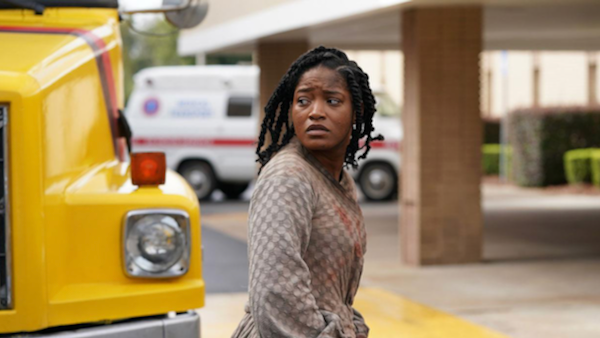Movie review by Greg Carlson
Krystin Ver Linden’s feature debut “Alice” premiered in the U.S. Dramatic Competition section at the 2022 Sundance Film Festival and arrives in theaters March 18. The Sundance press notes described the movie as “equal parts earthy Southern Gothic and soulful Blaxploitation,” but critical reactions since its January debut have been decidedly mixed. The imaginative genre-mashup works in fits and starts, but there is no question about the quality of lead Keke Palmer’s smooth Pam Grier-inspired performance – even if she inhabits a universe that never fully comes together for viewers. Theatrical box office potential for the Roadside Attractions limited release looks to be quiet.
Palmer’s protagonist, enslaved by cruel plantation owner Paul Bennet (Jonny Lee Miller), survives the horrors of daily assault, rape, and abuse by the cruel and inhumane monster for whom she toils. Ver Linden, who appends a title card suggesting the story was “inspired by true events,” claims to have drawn from the accounts of people who remained in bondage following the Emancipation Proclamation. This basic premise was also used in Gerard Bush and Christopher Renz’s problematic “Antebellum,” another messy and uneven feature led by a performance (Janelle Monae in the 2020 movie) stronger than either the script or the direction.
In an interview with Julia Teti for “She Knows,” Ver Linden cites the story of Mae Miller, whose own “involuntary servitude” concluded in Mississippi in the 1960s, as the true-life account that stuck with the filmmaker during the creative process. In “Alice,” like other films that operate using variations of the City in a Bottle trope, we discover that the period setting is not, in fact, the mid 1800s. When a bewildered Alice escapes to a stretch of highway and nearly gets creamed by a truck driven by one-time Black Panther Frank (Common), Ver Linden reveals that the setting is 1973. In an instant, everything Alice thinks she knows about the world is erased.
Once the determined heroine trades her braids for an afro – Ver Linden’s most prominent visual signifier of her movie’s indebtedness to “Coffy,” “Foxy Brown,” and other action-packed 70s-era revenge thrillers – the film lurches toward a predictable showdown that fails to deliver the kind of ass-kicking violence perfected by Grier. Odie Henderson’s brutal takedown of “Alice” makes a series of compelling arguments against Ver Linden’s movie. While I am not sure whether the film features Common’s career-worst performance, I do concur that there is little chemistry shared between him and Palmer.
Henderson torches the “fetishistic lip service” paid to the cultural figures who ignite Alice’s outrage, suggesting that Ver Linden rushes her character’s transformation into radicalized freedom fighter. I don’t disagree that the director’s shorthand is too short, or that one must really suspend disbelief to enjoy “Alice.” There are, however, enough touches that make the film worth a look. In particular, I keep returning to a diner scene in which Alice confronts a white supremacist played by Alicia Witt. How we got there doesn’t make a lot of sense, but it’s one of the only sections of the movie that addresses the past/present divisions of the film both structurally and philosophically. “Alice” sorely needed more of this.
